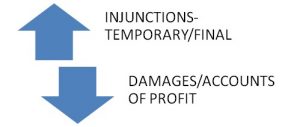By:- Prachi Parekh
INTRODUCTION:
Nowadays, people love to spend upon fashion-related products and this has helped the fashion industry to grow tremendously within a short span of time. The growth in the industry has led to employment generation and variety of career opportunities in the same, as well as innovative services and techniques are being welcomed by the industry. This has again led to growth and discovery of various new channels of providing these services and for which different contracts have to be created for each and every channel. Let us find out about various contracts that can be made under this industry.
TYPES OF CONTRACTS IN THE FASHION INDUSTRY AND CLAUSES CONTAINED IN THEM:
- CONSIGNMENT CONTRACT: This is a contract between a retailer and his agent wherein the retailer grants the right to sell, merchandise, conduct an exhibition for sale of the fashion apparel or inventory. Here, the retailer is called as consignor and his agent as consignee in the whole contract.
Learn more about Contract Drafting with Enhelion’s Online Law firm certified Master Course!
CLAUSES IN CONSIGNMENT CONTRACT[1]:
- Preamble: It depicts the details and facts of whole contract in short
- Duration clause
- Terms of sale of products clause
- Percentage that each party would receive clause or Consignment fee clause
- Payment options clause
- Liability for lost or damaged stock clause or Insurance Clause
- Effect on non-sale clause
- Minimum Price clause:the price below which the fashion products should not be sold
- Location and storage of stock during consignment clause
- Expenses clause
- Modification/Amendment clause
- Applicable law clause
Learn more about Contract Drafting with Enhelion’s Online Law firm certified Master Course!
- SHOWROOM RENT CONTRACT: It is a contract between the shop owner or showroom owner and the designer of fashion products for renting out the shop space to sell his stock. It is a type of a rent contract between these parties wherein the shop owner grants his shop to the designer against periodical payments of rent for the letting.
CLAUSES IN SHOWROOM RENT CONTRACT:
- Preamble
- Duration clause
- Expenses clause
- Terms of the rent payment clause
- Applicable law clause
- Dispute Resolution clause: In which court to refer the dispute in is included in it.
- Terms of letting clause: for example, whether the showroom will be furnished or not
- Payment of taxation clause
- Breach of contract clause
- Liability for damage to the showroom clause
- Security deposit clause: the amount of deposit to be given by the designer to the owner for rent
- Modification/Variation clause
- Termination clause: it also includes notice period to be given to each other
- FRANCHISE CONTRACT IN FASHION INDUSTRY: This is acontract wherein one party grants the authority to other to open and operate the business in the name of the selling party. The party granting such a right is called as a franchisor and other party is termed as a franchisee. We find many franchises in fashion industry such as Being Human,Fittin, Choupette, Duke, lenskart.com, Bombay dyeing[2], etc.
CLAUSES UNDER FRANCHISE CONTRACT IN FASHION INDUSTRTY:
- Preamble
- Franchise fee clause
- Security Deposit clause
- Royalties clause
- Mode of Payment clause
- Confidentiality clause: wherein the franchisee agrees not to disclose franchisor’s trade secrets
- Standards of Operations clause: wherein fixed set of standards have been set and the franchisee needs to follow them accurately
- Inspection clause: Right of franchisor to inspect the premises at regular intervals
- Applicable laws clause
- Proper registrations by franchisor relating to licenses clause
- Advertising and Brand Promotion clause
- Training, supervision and support clause
- Use of trademark and intellectual property clause: This is one of the most important clauses wherein the franchisor needs to have registered the trademark and should have exclusive rights for use of such a trademark
- Duration of contract clause
- Renewal clause
- Termination of contract clause
- Dispute Resolution clause: for example, arbitration, mediation, conciliation
- Force Majeure clause: Wherein any of the parties fails to perform their functions due to unforeseen circumstances, then what should be done?
- FASHION RELATED ADVERTISING AND PROMOTIONAL CONTRACT: It includes a contract between a designer/retailer/manufacturer of fashion products and an advertising and marketing agency for promoting these products through various channels in exchange of an advertising fee.
CLAUSES UNDER FASHION RELATED ADVERTISING CONTRACT:
- Preamble
- Duration of contract
- Scope of Work clause
- Budget and Payment schedule clause
- Advertising fee/price clause
- Consequences of late payment clause
- Breach of contract clause
- Termination clause
- Dispute Resolution Clause
- Copyright clause: This ensures that the ad agency is properly disclosing all the due credits and information relating to their use of any product or services which leads to prevention in copyright violations.
- Confidentiality clause
- Indemnity clause: If the designer/retailer/manufacturer faces any financial hit, or some similar situation and has not paid the ad agency as per the terms of the contract, then they will need to indemnify the ad agency for their loss
- Terms and conditions clause
Learn more about Contract Drafting with Enhelion’s Online Law firm certified Master Course!
- FASHION INDUSTRY EMPLOYMENT CONTRACTS:The employment contracts in fashion industry have a wide range. These can include employment for modelling and acting, designing, stitching, manufacturing, transportation and distribution/shipping of fashion products.
CLAUSES OF FASHION RELATED EMPLOYMENT CONTRACTS[3]:
- Preamble: Information relating to the facts for entering into the contract, parties and type of employment
- Duration clause
- Force Majeure clause
- Salary/Wages/Remuneration related clause
- Number of working days clause
- Confidentiality clause
- Annual/sick Leave clause
- Maternity/Paternity leave clause
- Liability for breach of contract clause
- Termination clause
- Dispute resolution clause
- Places to be worked at clause
- Other perks or social benefits clause
- Overtime clause
- Retrenchment Benefits clause
- Outsourcing/ sub-contracting clause
- Restrictions/prohibitions in employment clause: Sometimes there may be restrictions to the person being employed by and an employer in the fashion industry relating to age, marriage etc and is included in this clause.
- Survivability clause
- Severability clause
Learn more about Contract Drafting with Enhelion’s Online Law firm certified Master Course!
- OUTSOURCING CONTRACTS IN FASHION INDUSTRY:These contracts include outsourcing certain services or products which are important to the fashion industry. For example, fashion events management services, human resource services, apparel outsourcing, technology outsourcing.
CLAUSES UNDER FASHION OUTSOURCING CONTRACTS INCLUDE[4]:
- Preamble: including the reason, facts and details of parties entering into the contract
- Retained Rights clause: Each party retains certain rights with respect to title, interest etc
- Terms and conditions clause: It may include that the services or products must be of good quality and free from any defects
- Remuneration clause
- Duration clause
- Liability for Breach clause
- Confidentiality clause
- Survivability clause: it ensures that even after the contract has been performed certain terms and conditions in the contract will still remain in force, this is because of the confidentiality and non-disclosure clause, as the trade secrets have to be kept secret even after completion of the performance to the contract.
- Termination clause
- Guarantee/Warrantee clause
- Modification/Amendment clause
- Technical assistance clause
- Territories of providing services clause
- Inspection and acceptance clause
- Applicable Law clause
- Severability clause:Due to any uncertainty if provision of this contract becomes unlawful or impossible to perform, then this clause ensures that the whole contract is not termed as unenforceable but except the certain provisions remaining of the contract remains in force with full validity.
- Independent contractor clause
- Dispute resolution clause
CONCLUSION:
Thus, as we saw above these were some of the different types of contracts under the fashion Industry and some of which though contains similar clauses but are also specialised as per their work. Some clauses such as severability, survivability, dispute resolution, applicable governing laws, confidentiality clause, force majeure clause are amongst the most important clauses which safeguards the contract against uncertain or unforeseen events that can make the contract disputable or void. Inserting these clauses ensures that the contract remains in force and is termed to be valid. The non-disclosure clause also ensures that the valuable trade secrets are not revealed by the parties to the contract and the survivability clause exists even after the parties have finished dealing or performing as per the contract and if such a term is breached, the consequences need to be faced by the defaulting party as per the provisions in that effect in the respective contract.
[1]https://www.pandadoc.com/consignment-agreement-template/
[2]https://topfranchise.com/articles/the-top-10-fashion-franchise-businesses-in-india/
[3]https://legaltemplates.net/form/employment-contract/
[4]https://www.pandadoc.com/business-contract-template/


